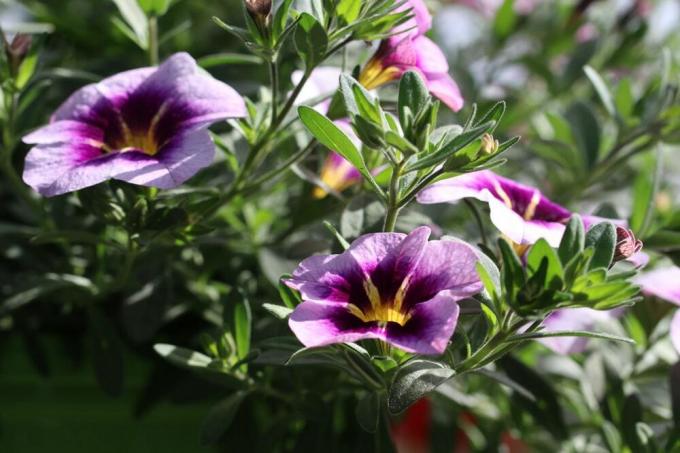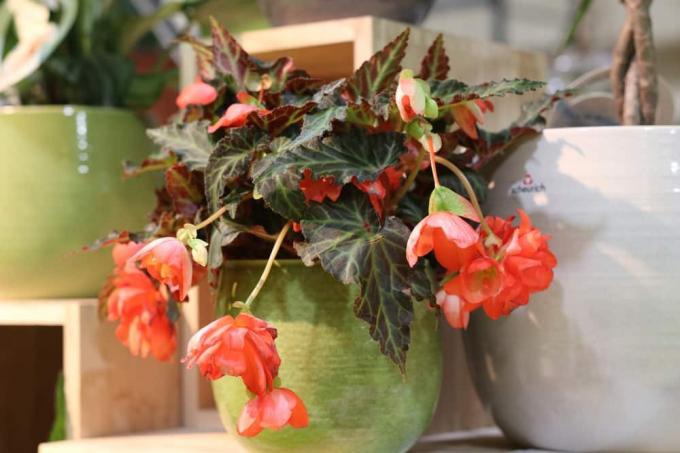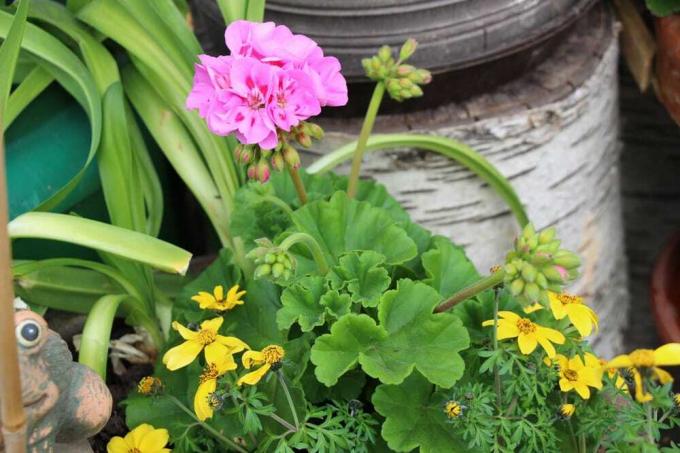

Table of contents
- growth and flowering
- Popular Varieties
- Location
- substrate
- Plant
- Pour
- Fertilize
- Cut
- multiply
- diseases and pests
- hibernate
With their wonderful trumpet flowers, petunias have a long tradition in our gardens. Different varieties compete diligently for the favor of the viewer. In summer, ideally, each plant has more flowers than leaves. Petunia Serfinia is a special breed that offers the flower dance even under less than optimal conditions. Read here what care drives this hybrid to bloom.
growth and flowering
In the language of the Brazilian natives, Petun means tobacco. The petunia is in fact also related to the tobacco plant. It originally comes from tropical South America. The abundance of flowers carried them out into the world early on. The enthusiasm for this flowering miracle has now also produced hybrid varieties that thrive better in our latitudes. This also includes the Japanese breed Petunia Surfinia.
- upright varieties grow to a height of about 30 cm
- hanging varieties form tendrils up to one meter long
- are extremely keen to grow
- cope better with rain
- bloom in as little as 6 to 8 weeks
- large, funnel-shaped flowers
- Flowering time is from June
- plants that were brought earlier also flower earlier
- large selection of strong flower colors
- multicolored flowers are also possible
Popular Varieties
The surfinia is commercially available in many different varieties. The visible difference is the color of the flowers. But the individual varieties also differ in other properties, such as flower size, growth habit and sensitivity to cold. Below are some popular strains, sorted by flower color.
- White: Bright Dream, White,
- Blue: Blue, Sky Blue, Happy Sophia, Blue vein
- Red: Red, Ratio Red, Burgundy, Giant purple
- Yellow: Victorian yellow, yellow
- Pink: Hot red, Hot pin, Pink vein, Pastel, Repens Pink Star
- Violet: Amethyst, purple, purple var
- tricolor: Celebration Carnival (yellow, blue and red)
Location
All petunia varieties like the sun and the warmth that comes with it. The hybrid variety Petunia Surfinia is no exception. Shady places disrupt their development due to a lack of light. You should be spared these flowering masters. Every now and then raindrops are a natural part of an outdoor location. The Surfinia copes much better with this than conventional varieties. Nevertheless, a rain-protected place is more advantageous for her and should be made available to her if possible. In the interplay of natural forces, hanging varieties are also at the mercy of the wind, which treats their long shoots very roughly. Since the wind can unfortunately not be canceled, a wind-protected location must be found for this surfinia species.
- loves it sunny and warm
- does not like shade, then there is a risk of powdery mildew
- A lack of light also inhibits flowering
- the ideal location is protected from rain and wind
- only place outdoors in the frost-free season
A notice:
On the one hand, a very sunny petunia inspires with a flood of flowers. On the other hand, it has to be constantly supplied with water. Watering should rarely be "forgotten" for a day.
substrate

Anyone who enters a garden center is often amazed at the amount of soil mixtures on offer. A special substrate can be found for almost every type of plant, including petunias. This takes into account the expectations that this plant has of its soil. It should be a bit sour, then she feels at home and comfortable in it. If you do not want to buy this usually more expensive ready-mix, you can easily provide an acidic environment yourself. The basis is normal potting soil, which is additionally enriched.
- normal potting soil as a base
- nutritious and permeable
- add about the same amount of peat soil
- pH of 5.5 is optimal
Tip:
Pure potting soil has also proven its worth with petunias, but good quality is essential here. Only then is it good for the petunia.
Plant
Late spring is the right time to plant petunias. Only from mid-May are the plants no longer exposed to the icy threat of frost. The hybrid Petunia Surfinia is less sensitive to frost. You can start the gardening season a little earlier. It usually withstands any late night frosts well. Petunias look more voluminous and impressive in the company of other petunias, which is why it is popular to plant several plants in one container. However, their roots tend to spread, so avoid planting too close together. If several petunia species grow together, it is important to ensure that the varieties harmonize well with each other in terms of their requirements.
- 2 to 3 plants per hanging basket
- per large flower box approx. 5 plants
- Roots need space, don't plant too close together
- Planting distance should be min. be 15 cm
- they like water but not waterlogging
- Drainage layer in the vessel makes sense
- use nutrient-rich, well-drained and slightly acidic soil
- Add slow-release fertilizer
- add compost to upright varieties outdoors
Tip:
Planters with a water reservoir are ideal for thirsty petunias. You can use it to supply yourself with water for a few days. In this way, you can venture on your own weekend trip with a clear conscience.
Pour
Pour, pour and pour again. Morning, evening and every day. At least in the summer, on the particularly hot days. Every plant lover has to be prepared for this if he wants to bring this plant into full bloom. Petunias usually recover quickly from a short dry period. If it has to endure dry periods several times, it will be permanently weakened and magically attract diseases and pests.
- water regularly and plentifully
- at high temperatures twice a day
- morning and/or evening
- never water in the blazing midday heat
- use soft water, rainwater is a good choice
- enrich hard water with some iron fertilizer
- Pour water on the ground or in the water reservoir
- do not wet the leaves or flowers when watering
A notice:
The soil ball should always be moist. When the soil dries up, yellow leaves follow in no time. The moisture must be kept even with a sense of proportion, under no circumstances should it turn into waterlogging.
Fertilize
Petunias are heavy-duty plants. With their roots, they constantly suck nutrients from the surrounding soil. You should therefore expect a nutrient-rich mixture right from the start. Compost contributes to a secure supply, as does long-term fertilizer. Flowering plant fertilizer controls the rest.
- nutrient-rich soil
- Incorporate long-term fertilizer
- Flowering plant fertilizer 1-2 times a week
- throughout the season
Tip:
The best way to administer flowering plant fertilizer to the petunia is via the irrigation water.
Cut
All green shoots and the brightly colored flowers of the Surfinia are welcome, nothing needs to be cut away. However, all faded plant parts should be removed consistently and promptly. For one thing, the plant only looks much prettier with plump flowers. On the other hand, removing faded flowers always produces new flowers and shoots.
- Remove faded flowers and thus stimulate new growth
- Pinch off shoot tips if more branching is desired
Petunias, which have completed their flowering work and are allowed to rest in a winter quarters, now also require garden shears.
- all petunias that will be overwintered
- cut back before inserting
- Cut all shoots to about 20 cm in length
- remove thin and weak shoots in spring
multiply

Surfinia are hybrid plants that do not form seeds or do not form seeds that are capable of germinating. It is therefore not possible to propagate Surfinia seeds. They are easy to propagate from cuttings. And that goes like this:
- Cut off one or more shoots from the plant. These should be about 15 cm long.
- Remove any flowers and buds that are still attached.
- Also leave only two leaves.
- Place the cuttings in a glass of water to allow them to root first.
- Pot the cuttings once some roots have formed.
Tip:
After planting, pinch off the shoot tips of the young petunia regularly to encourage branching. This will give you a nice, dense growth.
diseases and pests
Breeding the Petunia Sufinia has produced a more robust plant, but this variety is still susceptible to pests. Therefore, pay close attention to possible signs so that you can react quickly. The following pests and diseases particularly often threaten petunia:
- aphids
- white bow tie
- powdery mildew
- different viruses
If the petunia is attacked by viruses, parts of the plant gradually die. Unfortunately, there is no effective remedy against this. Action can and should be taken against other diseases and pests. If the plant is not treated properly, it becomes susceptible to other diseases that can bring it down for good. It can also infect other plants.
- Nettle broth helps with aphids
- Soft soap solution is effective against aphids and whiteflies
- Yellow panels attract whiteflies
- Mixture of milk and water in a ratio of 1:9 combats powdery mildew
If you don't spot any pests on your petunia, yellowing leaves could also indicate a nutrient deficiency. Iron fertilizer quickly provides a remedy against the so-called chlorosis.
A notice:
Diseased petunias that you can no longer save should never end up on the compost heap.
hibernate
The fast-growing petunias are usually cultivated as annual plants. But it is quite possible to overwinter the plant and bring it to bloom again next year. Since the petunia varieties are not consistently hardy, they have to get through cold seasons indoors.
- bright and cool room is ideal
- Room temperature should be 5 to 10 degrees
- cut back all shoots
- to about 10 cm in length
- must go into winter quarters before frost
- water regularly even during the hibernation
- but only with small amounts of water
 garden editorial
garden editorial I write about everything that interests me in my garden.
Learn more about balcony plants

Eisbegonia, Begonia: care instructions from A - Z
The ice begonia is one of the most popular bedding plants, because they are characterized by their robustness and willingness to flower. When caring for ice begonias, there are a few points to consider when fertilizing and watering. As a houseplant, it is perennial and can be overwintered.

Begonia location: 3 important criteria
Begonias are easy-care plants. However, so that they can thrive and you can actually enjoy them, the location must be right. And that means above all: no direct sunlight, but shade or semi-shade. In addition, the soil should be as moist as possible.

Blue fan flower, Scaevola aemula: care from A - Z
Are you looking for an easy-care and robust flower for the balcony? Then the blue fan flower might just be the right plant for you!

16 popular hanging plants and how to care for them
Hanging plants aren't always a sad sight. At least not when nature intended it that way. Their tendrils weave a new dress on boring balcony walls in no time. Whether fast-growing, green, colorful or just easy to care for, every wish will be fulfilled.

13 balcony plants for sunny south-west balconies balcony flowers
A balcony with leafy or flowering plants delights both the heart and the eye. However, not every balcony plant is suitable for every balcony, because every plant makes specific demands on the location. We have put together for you which plants are particularly suitable for a south-west balcony.

Scented geraniums: care, propagation and overwintering scented geranium
Is it the lush growth? The brightly colored flowers? Or is it its beguiling scent that makes the scented geranium our favourite? Does she have any other trump cards? Yes! As beautiful as she is, she is also undemanding. Your care succeeds!
